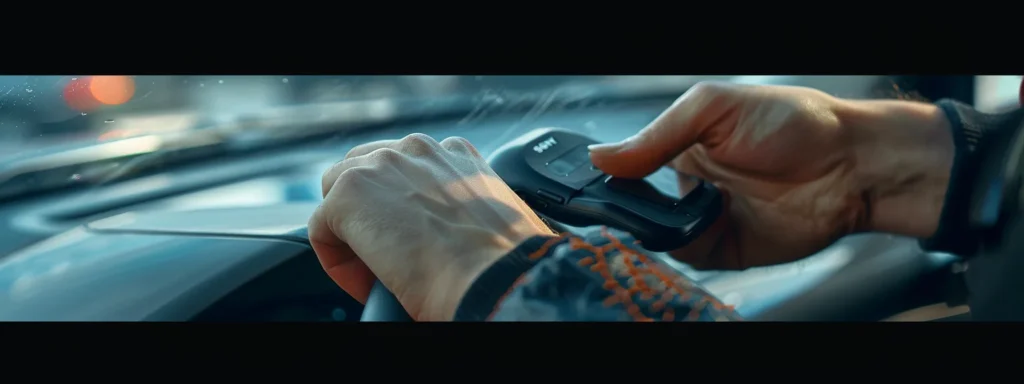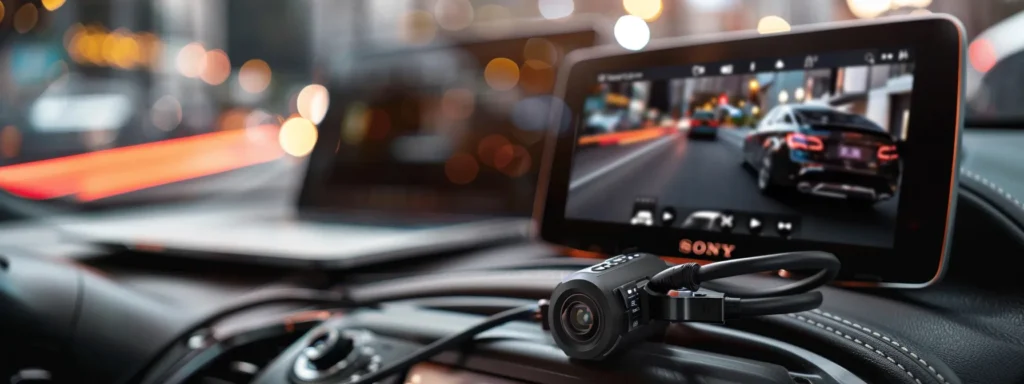Are you vigilant about security on the road, but overwhelmed by the intricacies of choosing a dash cam? This ultimate guide unlocks the potential of battery powered dash cams, featuring both front and rear models. Delve into the essentials – from discerning top models with the best night vision to simplifying installation steps. Discover the smart techniques to extend your dash cam‘s battery life and the optimal memory card practices tailored for UK truck drivers. With insights on syncing footage straight to your smartphone, this guide ensures you’re equipped with the tools for enhanced road safety and peace of mind.
123 Understanding Battery Powered Dash Cams 456

Battery powered dash cams provide motorists with a self-contained energy solution, attaching effortlessly to the windshield and offering impressive life expectancy. These devices boast advantages like effortless installation and image stabilization without the need to tether to the vehicle‘s electrical system. Consumers can select from varied types, each with distinct features such as loop recording and GPS tagging. It is, however, crucial to recognize limitations including energy consumption and storage capacity. The following sections will outline how these cams operate, the benefits they offer over hardwired options, the common features one might expect, and the potential constraints to bear in mind.
123 456 How Battery Powered Dash Cams Operate
Battery powered dash cams operate by harnessing the energy from lithium iron phosphate batteries, which are known for their long life and stability. These cams typically incorporate an anode made from lightweight materials, allowing for efficient energy usage during prolonged periods of surveillance. Unlike traditional GoPro cameras designed for dynamic activities, battery powered dash cams maintain a constant internet connection, enabling real-time monitoring and data transmission without interrupting the vehicle‘s electrical system.
Advantages Over Hardwired Dash Cams
Battery powered dash cams present clear advantages, including their ability to capture a wide angle of the road with minimal installation fuss. Front and rear models can be equipped with lenses that automatically adjust to lighting conditions, ensuring clear collision evidence is captured and saved directly to an SD card without reliance on a car’s power supply. This independence from the vehicle‘s electrical system not only simplifies the setup but also reduces the risk of draining the car battery or interfering with its electronic components.
Types of Battery Powered Dash Cams
Variety abounds in the market for battery powered dash cams, with models suited for both dashboard and motorcycle mounting that cater to diverse needs. Brands prioritize features such as infrared for enhanced night vision, and a broad field of view to capture more detail during both day and night rides. This enables motorists to document their journey comprehensively, ensuring all angles are covered and potential incidents are recorded with utmost clarity.
Common Features to Expect
When delving into the realm of battery powered dash cams, expect to encounter models with state-of-the-art Exmor sensors for superior low-light performance, designed to function seamlessly without the need for a power cable connected to the engine. These innovative devices often feature a mirror recording mode, ensuring that every critical moment on the road is documented from both front and rear perspectives. The integration of a robust battery negates the reliance on traditional power sources, enabling these dash cams to offer reliability and performance that motorists depend upon.
Limitations to Consider
While battery powered dash cams offer convenience, one must consider their limitations such as the need for periodic recharging or replacement of the external battery for dashcam units. Unlike cams wired directly into the fuse box, these cameras may not provide continuous backup camera functionality and could miss critical footage if not managed properly. Furthermore, in the realm of photography and video quality, the dependability on an internal battery can necessitate more frequent maintenance to ensure optimal performance, especially in extreme weather conditions where battery efficiency can be compromised.
Top Front and Rear Battery Powered Dash Cam Models

Embarking on the quest for the ideal battery powered dash cam brings to light options of front and rear models that stand apart. This section provides a discerning review of the best devices, contrasting their frame rate, high dynamic range capabilities, and integration with mobile phone apps. The featured models include reputable brands like Garmin, with an emphasis on their access to cloud storage. Insightful assessments of these models highlight their strengths and weaknesses through customer testimonials and robust ratings. Detailed considerations also encompass practical purchasing options and pricing specifics for informed decision-making.
Review of the Best Battery Powered Dash Cams
In the market for top-tier battery powered dashcams, models with touchscreen interfaces and crisp 1440p resolution are gaining traction. Meticulously designed battery packs extend the life and reliability of these devices, attracting considerable attention, especially when available at a competitive sale price. Consumers laud such dashcams for their blend of high-definition recording capabilities and user-friendly operation, ensuring even the novice user can capture crucial on-road events with clarity and ease.
Comparison of Key Features
In the quest to find the perfect dash cam, the comparison of key features is indispensable. Noteworthy is the integration of 4K resolution in front and rear models, which provides crystal-clear video quality unparalleled by standard definitions, capturing minute details on the road. Additionally, memory capacity is a significant factor; a larger memory allows for more footage storage, reducing the frequency of data transfers. Dash cams equipped with USB connectivity facilitate quick data transfer and power options, while advanced lithium technology ensures longevity and durability of the battery, underpinning the device’s reliability.
Pros and Cons of Popular Models
The most coveted battery powered dash cams offer the allure of cord-free setup, negating the need to wire equipment through the vehicle‘s interior, which streamlines the installation process and preserves the integrity of the car’s headliner. Each dashcam has its set of advantages; for example, the front and rear models provide comprehensive coverage of the road, capturing events with precision which could be critical in disputing a speed limit violation or unwarranted fee. However, users must weigh such benefits against drawbacks including potential battery replacement costs and the exigency for diligent management to avoid loss of crucial footage during extended drives.
Customer Testimonials and Ratings
Customer testimonials and ratings often reflect the real-world performance of battery powered dash cams across various scenarios, from taxi services monitoring passenger behavior to individuals documenting speed on busy roads. Positive feedback commonly highlights the seamless connectivity of these cams to mobile apps via Bluetooth, allowing for swift review and sharing of high-resolution footage. Meanwhile, users frequently praise the superior video quality of leading models, underscoring their confidence in capturing clear evidence whenever it’s needed.
Where to Purchase and Pricing Details
For those seeking to procure top-of-the-line battery powered dash cams, options are abundant online and in electronics stores. Models boasting 1080p resolution ensure that visibility on footage is clear, which can be paramount when submitting evidence for insurance claims. It is imperative for consumers to understand that while advanced camera lens technology may impact pricing, investing in a high-quality dash cam can mitigate the risk of battery drain and ultimately save costs related to vehicle damage. Prices vary, but the quality and features of the dash cam should be the guiding factors for buyers who prioritize dependable performance and security on the road.
How to Choose the Best Battery Powered Dash Cam

Selecting the right battery powered dash cam involves careful consideration of key features that align with your needs. Essential elements to look for include the ability to record with minimal vibration, exceptional light handling for clear footage day and night, and a price that fits your budget. Prioritize video quality and resolution to ensure fine details are captured, while battery life and power options dictate operational time. Memory capacity and storage solutions are critical for keeping valuable recordings secure, with additional features improving overall performance. The forthcoming analysis will dissect these aspects, aiding users in making an informed decision.
Essential Features to Look For
In the quest for the ideal battery powered dash cam, motorists should prioritize models with a high frame rate and a potent sensor capable of capturing crisp, smooth footage, particularly in fast-moving scenarios. It is paramount to consider how a dash cam copes with heat, to ensure consistent performance in varying climates. Furthermore, a dual-channel (2ch) system, which provides both front and rear coverage, is essential for comprehensive surveillance of a vehicle‘s surroundings. Navigating through options can be overwhelming, but focusing on these fundamental features will steer consumers towards a reliable addition to their vehicular safety toolkit.
Evaluating Video Quality and Resolution
When choosing a battery powered dash cam, video quality and resolution are paramount; they dictate the clarity with which incidents and details are captured, particularly in low-lighting conditions. High-definition resolutions, backed by reputable brands like Sony, utilize advanced sensors that excel in variable lighting and motion capture. Furthermore, the inclusion of a supercapacitor rather than a typical lithium battery can improve storage capabilities and the device’s durability, ensuring reliable performance and safeguarding valuable footage over time.
Considering Battery Life and Power Options
When scrutinizing battery powered dash cams for purchase, decisive consideration must be given to battery life and power options, which are essential in the context of reliability and longevity. Dash cams from Nextbase, a prominent brand in the United States, offer ion battery technology that can significantly prolong camera operation, thereby ensuring footage of an accident is captured without fail. Motorists should seek cameras that balance extended battery life with efficient power management, to record critical incidents fully and without interruption.
Assessing Memory Capacity and Storage Solutions
When evaluating the storage solutions of battery powered dash cams, one should rigorously consider memory capacity to ensure the camera‘s power supply and voltage can accommodate extended recording sessions without data loss. A robust electricity management system is vital for sustaining an action camera‘s operation and safeguarding recorded safety footage. Users are advised to seek dash cams that offer ample storage space or the capability to use high-capacity SD cards, which ensures that important evidence is preserved even during long journeys or in high-resolution recording modes. This careful assessment of storage solutions directly correlates to a dash cam‘s reliability, ultimately supporting the user’s overarching need for safety and security on the road.
Additional Features That Enhance Performance
For the discerning vehicle owner, additional features of a dashcam battery-powered system can markedly enhance performance and user experience. Integration with menu interfaces that support voice commands, such as Amazon Alexa, offers hands-free operation, which is a significant safety feature while driving. Furthermore, selecting a dashcam with a rechargeable battery not only promotes environmental sustainability but also assures ongoing operational readiness, eliminating the inconvenience of frequently purchasing disposable batteries. These features, collectively, bring convenience and boosted functionality to the routine operation of battery powered dash cams.
Installation and Setup of Your Battery Powered Dash Cam

Transitioning from the fundamentals to practical application, this section delves into the meticulous process of setting up your battery powered dash cam. A detailed Step-by-Step Installation Guide will pave the way, demonstrating how to place and secure both front and rear cameras for comprehensive coverage. Readers will learn essential Tips for Optimal Recording Angles and the benefits of effective Positioning of Front and Rear Cameras. Additionally, guidelines for Syncing With Smartphones or Other Devices for seamless connectivity will be discussed, along with solutions for Troubleshooting Common Installation Issues, ensuring a smooth and efficient setup experience. Practically addressing concerns relating to image quality, firmware updates, energy storage, and the usage of capacitor technology, each segment will provide hands-on insights for users aiming to enhance their vehicle’s security.
Step-by-Step Installation Guide
To securely affix your battery powered dash cam, initiate by locating a spot on the windshield that affords a clear field of view without obstructing the driver’s sightline. Adhere the mounting base—often a suction cup or adhesive pad—firmly onto the glass, then connect the dash cam to the mount, usually with a simple sliding or clicking mechanism. It’s imperative to ensure the camera lens is aligned properly; the horizon should be centered within the frame to capture footage effectively. Once mounted, power on the device to confirm functionality and adjust settings as necessary, considering factors like resolution and loop recording length. This straightforward installation process equips drivers to monitor their surroundings with ease.
Positioning Front and Rear Cameras Effectively
Effectively positioning front and rear cameras is pivotal for maximizing the coverage and utility of battery powered dash cams. Ensuring the front camera is mounted at the center of the windshield, just behind the rearview mirror, helps avoid blind spots and provides an unobstructed view. Likewise, placing the rear camera on the back window, centered and high up, allows for a wide-angle capture of the road behind. This strategic placement aids in documenting all aspects of a journey, providing comprehensive footage that could be crucial in the event of an incident.
Tips for Optimal Recording Angles
To achieve optimal recording angles for a battery powered dash cam, one must ensure the device is positioned to capture a wide, unobstructed view while avoiding glare or reflections. The front camera should be angled slightly downwards to record both the road ahead and the dashboard, whereas the rear should encompass the full scope of the road behind the vehicle. Accurate alignment of these recording angles is crucial for documenting incidents and avoiding blind spots, thus providing motorists with reliable video evidence in case of road events or accidents.
Syncing With Smartphones or Other Devices
Syncing a battery powered dash cam with smartphones or other devices elevates the user experience by enabling remote access to footage and simple management of settings. After the installation, motorists can utilize dedicated apps to connect their dash cams to mobile devices via Wi-Fi or Bluetooth. This connectivity allows for immediate viewing, downloading, and sharing of videos, providing users with quick evidence retrieval following road incidents or during travel documentation, right from the palm of their hand.
Troubleshooting Common Installation Issues
When facing common installation issues with battery powered dash cams, drivers may encounter malfunctions such as insufficient battery life or unclear video quality. Resolving these concerns requires checking connections for security and battery health, ensuring the device is charged fully before use. It’s also vital to position the lens away from direct sunlight to prevent glare and to adjust settings for optimal exposure, guaranteeing crisp, clear footage. Troubleshooting effectively enhances the longevity and performance of your dash cam, affording peace of mind on the road.
Maximizing the Battery Life of Your Dash Cam

Ensuring the longevity of your battery powered dash cam hinges on adopting efficient charging techniques, such as adhering to recommended charging schedules and leveraging power-saving modes. Regular firmware updates are also critical for maintaining operational efficiency, while routine maintenance practices contribute substantially to the camera‘s lifespan. It is equally important to recognize the signs that indicate the need to replace the dash cam battery, to avoid unexpected power loss. The upcoming sections will examine these strategies in detail, providing car owners with crucial insights for maximizing the durability and reliability of their dash cam‘s power source.
Proper Charging Techniques and Schedules
Adhering to proper charging techniques and schedules is essential for optimizing the lifespan of a battery powered dash cam‘s power source. For instance, users should fully charge the device before the initial use and avoid letting the battery completely discharge, as this helps maintain the battery’s health over time. Moreover, by implementing regular charging intervals and utilizing the dash cam‘s power-saving features, owners can ensure that their devices remain operational for longer periods, providing consistent surveillance without the inconvenience of frequent power depletion.
Utilizing Power-Saving Modes
Activating power-saving modes on battery powered dash cams enables motorists to extend the operational duration of their devices considerably. By reducing power consumption when the vehicle is stationary, these modes help preserve energy, ensuring the dash cam remains active and ready to record in the event of a collision or movement detection. Such judicious use of power not only mitigates the frequency of charging but also serves as a safeguard, guaranteeing that key moments are captured even during prolonged periods of inactivity.
Keeping Firmware Updated for Efficiency
Keeping the firmware of battery powered dash cams updated is crucial for maintaining energy efficiency and ensuring the device operates at peak performance. Manufacturers often release firmware updates that optimize the device’s power management algorithms or improve the functionality of power-saving modes. Regularly checking for and installing these updates helps not only in ironing out any software creases that might drain battery life but also assures that the dash cam functions effectively and reliably, capturing crisp, clear footage when it matters most.
Maintenance Practices for Longevity
Maintenance practices for longevity are key to sustaining the performance of battery powered dash cams. Users should regularly clean the lens to ensure clarity and check battery connections to prevent power interruptions. It is advisable to store the dash cam in a moderate temperature to avoid exposure to extreme heat or cold, which can degrade battery health. These simple yet effective steps assist in extending the life of the camera and ensuring it continues to provide reliable service over time.
Recognizing When to Replace the Battery
Recognizing the appropriate time to replace the battery in a dash cam is essential for maintaining uninterrupted recording capabilities. When the dash cam struggles to hold a charge or powers down sooner than expected, it signals a weakened battery that may compromise the device’s reliability. Car owners should remain vigilant for these signs and consider timely battery replacement to ensure their dash cam continues capturing essential footage without fail.
Frequently Asked Questions About Battery Powered Dash Cams

Navigating the complexities of using a battery powered dash cam, vehicle owners may have pressing questions about legality, power consumption, data management, and security. This section addresses these concerns, starting with the rules surrounding dash cam use in various locations, the likelihood of vehicle battery drainage, and the procedures for transferring and viewing recorded footage. Insight on memory card capacity and steps to deter theft round out these essential queries. Each following subsection offers in-depth answers, ensuring drivers are well-equipped to make the most of their dash cams.
Are Battery Powered Dash Cams Legal in My Area?
The legality of battery powered dash cams varies by region, with some areas permitting them as long as they do not obstruct the driver’s view or record private conversations without consent. Vehicle owners should verify their local traffic regulations and privacy laws to ensure compliance when installing and operating a dash cam. Understanding these legal nuances is crucial for motorists to safeguard against potential violations while benefiting from the security and documentation that dash cams provide.
Can a Dash Cam Drain My Vehicle’s Battery?
One may wonder if a battery powered dash cam could potentially drain a vehicle‘s battery. The answer lies in the cam‘s design; these units, especially when powered by their own batteries, have a minimal impact on a car’s electrical system. However, it’s crucial for vehicle owners to ensure the dash cam is charged independently and not reliant on the car’s power for long periods, which could lead to unwanted battery depletion. By selecting a dash cam with efficient power management and utilizing its power-saving features, drivers can mitigate any risk of draining their vehicle‘s battery while maintaining continuous surveillance.
How Do I Transfer and View Recorded Footage?
Transferring and viewing recorded footage from battery powered dash cams is a straightforward process. Users can typically remove the SD card from the device and insert it into a computer to access the files directly. Alternatively, many modern dash cams now come with Wi-Fi or Bluetooth capabilities, allowing drivers to wirelessly sync the footage to their smartphones or tablets through a dedicated app, providing convenience and ease of access to review and store valuable recordings securely.
What Happens When the Memory Card Is Full?
When a memory card in a battery powered dash cam reaches full capacity, the device typically employs a loop recording feature, where newer footage automatically overwrites the oldest files, ensuring continuous recording without manual intervention. This process allows vehicle owners to drive with the assurance that their dash cams will not cease recording crucial events due to full storage, safeguarding their ability to capture vital on-road evidence at all times.
How Can I Protect My Dash Cam From Theft?
To safeguard a dash cam from theft, vehicle owners should consider models with discreet designs that blend in with the vehicle‘s interior or with detachment features that allow for easy removal when leaving the car unattended. Additionally, utilizing in-built security functions such as password protection can prevent unauthorized access to the device. It’s also advisable to park in well-lit, secure areas and attach the dash cam in a position that is not easily noticeable from outside to reduce the risk of theft.
Conclusion
Understanding the ins and outs of battery-powered dash cams is crucial for anyone looking to enhance their vehicle‘s security and document their journeys. These devices offer the ease of cordless installation, a variety of compelling features like loop recording and night vision, and the flexibility to maintain continuous surveillance without taxing the car’s battery. It’s imperative to choose a model that fits individual needs by considering factors such as battery life, storage capacity, and video quality. Ultimately, investing in a reliable front and rear battery-powered dash cam can provide motorists with peace of mind and vital evidence in the event of unforeseen road incidents.
